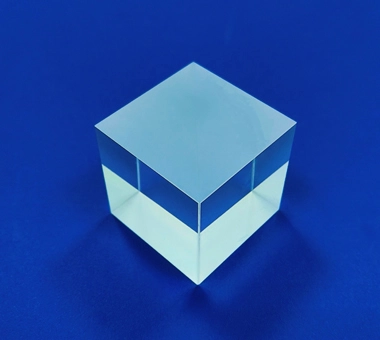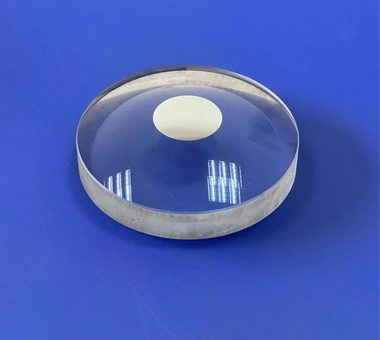
Call Us
86-755-82924037
Call Us
86-755-82924037Achromatic triplet lenses minimize Seidel aberrations, usually by gluing three lenses together or mounting three lenses in a housing. Suitable for measurement and imaging applications such as projection, photography, fluorescence microscopy, image relay, inspection, spectroscopy, etc. After milling, fine grinding, grinding and polishing, the single lens in the glued lens can reach the optical surface accuracy ≤0.1 micron, and the surface roughness Ra≤0.01 micron. Three aspheric achromatic lenses are combined to form an achromatic triplet lens. The achromatic triplet lens is glued by using a centering device with a curing device with UV photosensitive adhesive for precision bonding and eccentricity testing.
| Achromatic Triplet Lenses product parameter table | ||
| Project | Indicator requirements | |
| 1.Material | A variety of high and low refractive index optical glass, ultraviolet fused quartz elements, optical quartz and other materials | |
| 2.Outer Diameter | Round OD≤300mm, Square L×W≤210×210mm ±0.05mm | |
| 3.Center Thickness | T≤100mm±0.02 or according to customer requirements | |
| 4. Effective focal length | according to customers needs | |
| 5. Working distance | according to customers needs | |
| 6. Design wavelength | according to customers needs | |
| 8.Coating | AR anti-reflection coating R < 0.5%@λnm according to customers needs | |
| 9.eccentricity | according to customers needs | |
| 10. Effective aperture | ED>90% aspherical area | |
| 11. Surface Shape | Ultra-high precision Rt≤0.1μm, high-precision Rt≤0.5μm, precision Rt≤1μm | |
| 12.Surface quality | 60-40, 40-20, 20-10, 10-5 | |

One-stop customized production: Solar Valley processes a variety of round and square achromatic triad lenses, such as positive achromatic lens, negative achromatic lens, asspherical achromatic lens and so on achromatic lenses, according to customer requirements.
Achromatic Triplet Lens Material: Use a variety of high and low refractive index optical glass, calcium fluoride lenses, optical quartz, fused quartz substrates, and other materials.
Achromatic triplet lens performance: Tianyang Valley strictly matches the diameter and center thickness to ensure the adhesive thickness and the center thickness required by high precision. Using UV curing/gluing technology on different glass materials, Tianyang Valley dynamically adjusts the optical center of the three parts during the gluing process, eliminating the overall optical center eccentricity after gluing. For high refractive index optical materials, the use of high refractive index UV photosensitive adhesive corresponding, accurate control of the center thickness tolerance of the adhesive can be used for optical design that is very sensitive to air spacing. From ultraviolet to near-infrared achromatic lenses, the operating band can be 193nm to 1000nm, achieving a consistent focal length and minimizing spherical aberration performance.
Achromatic Triplet Lens Product size indicator description:
Achromatic triplet lens maximum dimensions: OD≤φ300mm
The maximum external dimension of the square achromatic triad lens: L×W≤210×210mm achromatic triad lens center thickness T≤100mm
Achromatic triplet lenses can achieve the following accuracy levels according to customer requirements:
Ultra-high precision: surface shape error < 0.1μm, surface roughness < 0.01μm
High precision grade: Surface error < 0.5μm, surface roughness < 0.05μm Precision grade: Surface error < 1μm, surface roughness < 0.1μm
Achromatic Triplet Lens Surface defect grade: 60-40, 40-20, 20-10, 10-5 According to customer requirements.
Achromatic Triplet Lens Coating: Coating according to customer requirements.
Recent advancements in achromatic triplet and aspheric achromatic lens technology have significantly enhanced precision optics, providing improved image clarity and reduced chromatic aberrations. The achromatic triplet lens, known for its ability to correct color distortion across a wider spectrum, is now more efficient and widely used in applications such as high-resolution imaging and microscopy. In parallel, the achromatic aspheric lens combines the benefits of aspheric surfaces with achromatic correction, allowing for sharper focus and reduced optical distortion. Additionally, the development of the achromatic triplet lens has revolutionized various fields by offering enhanced performance and versatility. These innovations are crucial for industries requiring high-precision optical components, including astronomy, medical imaging, and advanced manufacturing.
| Types | Products |
| A. Optical Lenses & Components | Germanium Lens Price |
| Cemented Achromatic Doublet | |
| Magnesium Fluoride Lens | |
| Laser Lens Factory | |
| Optical Glass Prism Cube | |
| Dichroic Mirror Price | |
| UV Dome | |
| Corner Cube China | |
| B. Optical Subassemblies (TOSA/ROSA/BOSA) | Transmitter Optical Sub Assembly (TOSA) |
| Receiver Optical Sub Assembly (ROSA) | |
| Bidirectional Optical Subassembly (BOSA) | |
| C. Quartz/Glass Products | Quartz Rods for Sale |
| Quartz Capillary Tube | |
| Quartz Capillaries | |
| Thin Wall Glass Tubing |


